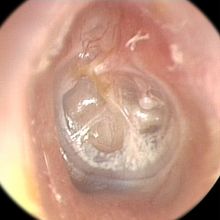
Tympanic membrane retraction

Tympanic membrane retraction describes a condition in which a part of the eardrum lies deeper within the ear than its normal position. Tympanic membrane retraction describes a condition in which a part of the eardrum lies deeper within the ear than its normal position. The eardrum comprises two parts, the pars tensa, which is the main part of the eardrum, and the pars flaccida, which is a smaller part of the eardrum located above the pars tensa. Either or both of these parts may become retracted. The retracted segment of eardrum is often known as a retraction pocket. The terms 'atelectasis' or sometimes 'adhesive otitis media' can be used to describe retraction of a large area of the pars tensa. Tympanic membrane retraction is fairly common and has been observed in one quarter of a population of British school children. Retraction of both eardrums is less common than having a retraction in just one ear. It is more common in children with cleft palate. Tympanic membrane retraction also occurs in adults. Attempts have been made to categorise the extent of tympanic membrane retraction though the validity of these classifications is limited. The majority of tympanic membrane retractions do not cause any symptoms. Some cause hearing loss by restricting sound-induced vibrations of the eardrum. Permanent conductive hearing loss can be caused by erosion of the ossicles (hearing bones). Discharge from the ear often indicates that the retraction pocket has developed into a cholesteatoma.
